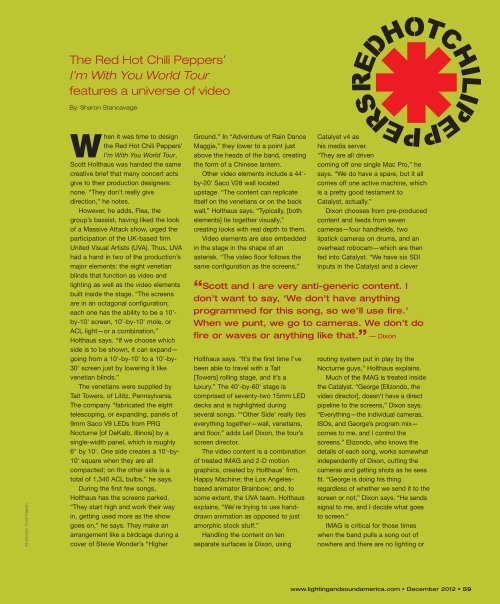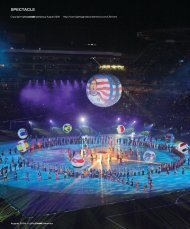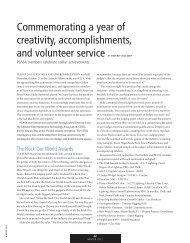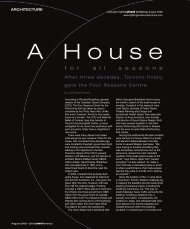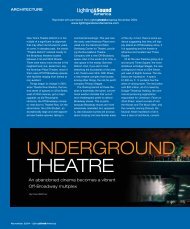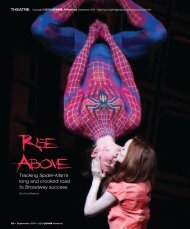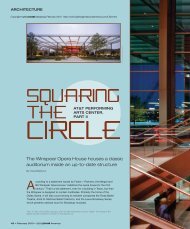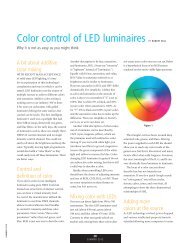LSA template - Lighting & Sound America
LSA template - Lighting & Sound America
LSA template - Lighting & Sound America
Create successful ePaper yourself
Turn your PDF publications into a flip-book with our unique Google optimized e-Paper software.
The Red Hot Chili Peppers’<br />
I’m With You World Tour<br />
features a universe of video<br />
By: Sharon Stancavage<br />
All photos: Todd Kaplan<br />
When it was time to design<br />
the Red Hot Chili Peppers’<br />
I’m With You World Tour,<br />
Scott Holthaus was handed the same<br />
creative brief that many concert acts<br />
give to their production designers:<br />
none. “They don’t really give<br />
direction,” he notes.<br />
However, he adds, Flea, the<br />
group’s bassist, having liked the look<br />
of a Massive Attack show, urged the<br />
participation of the UK-based firm<br />
United Visual Artists (UVA). Thus, UVA<br />
had a hand in two of the production’s<br />
major elements: the eight venetian<br />
blinds that function as video and<br />
lighting as well as the video elements<br />
built inside the stage. “The screens<br />
are in an octagonal configuration;<br />
each one has the ability to be a 10'-<br />
by-10' screen, 10'-by-10' mole, or<br />
ACL light—or a combination,”<br />
Holthaus says. “If we choose which<br />
side is to be shown, it can expand—<br />
going from a 10'-by-10' to a 10'-by-<br />
30' screen just by lowering it like<br />
venetian blinds.”<br />
The venetians were supplied by<br />
Tait Towers, of Lititz, Pennsylvania.<br />
The company “fabricated the eight<br />
telescoping, or expanding, panels of<br />
9mm Saco V9 LEDs from PRG<br />
Nocturne [of DeKalb, Illinois] by a<br />
single-width panel, which is roughly<br />
6" by 10'. One side creates a 10'-by-<br />
10' square when they are all<br />
compacted; on the other side is a<br />
total of 1,340 ACL bulbs,” he says.<br />
During the first few songs,<br />
Holthaus has the screens parked.<br />
“They start high and work their way<br />
in, getting used more as the show<br />
goes on,” he says. They make an<br />
arrangement like a birdcage during a<br />
cover of Stevie Wonder’s “Higher<br />
Ground.” In “Adventure of Rain Dance<br />
Maggie,” they lower to a point just<br />
above the heads of the band, creating<br />
the form of a Chinese lantern.<br />
Other video elements include a 44'-<br />
by-20' Saco V28 wall located<br />
upstage. “The content can replicate<br />
itself on the venetians or on the back<br />
wall,” Holthaus says. “Typically, [both<br />
elements] tie together visually,”<br />
creating looks with real depth to them.<br />
Video elements are also embedded<br />
in the stage in the shape of an<br />
asterisk. “The video floor follows the<br />
same configuration as the screens,”<br />
Holthaus says. “It’s the first time I’ve<br />
been able to travel with a Tait<br />
[Towers] rolling stage, and it’s a<br />
luxury.” The 40'-by-60' stage is<br />
comprised of seventy-two 15mm LED<br />
decks and is highlighted during<br />
several songs. “‘Other Side’ really ties<br />
everything together—wall, venetians,<br />
and floor,” adds Leif Dixon, the tour’s<br />
screen director.<br />
The video content is a combination<br />
of treated IMAG and 2-D motion<br />
graphics, created by Holthaus’ firm,<br />
Happy Machine; the Los Angelesbased<br />
animator Brainbow; and, to<br />
some extent, the UVA team. Holthaus<br />
explains, “We’re trying to use handdrawn<br />
animation as opposed to just<br />
amorphic stock stuff.”<br />
Handling the content on ten<br />
separate surfaces is Dixon, using<br />
Catalyst v4 as<br />
his media server.<br />
“They are all driven<br />
coming off one single Mac Pro,” he<br />
says. “We do have a spare, but it all<br />
comes off one active machine, which<br />
is a pretty good testament to<br />
Catalyst, actually.”<br />
Dixon chooses from pre-produced<br />
content and feeds from seven<br />
cameras—four handhelds, two<br />
lipstick cameras on drums, and an<br />
overhead robocam—which are then<br />
fed into Catalyst. “We have six SDI<br />
inputs in the Catalyst and a clever<br />
“ Scott and I are very anti-generic content. I<br />
don’t want to say, ‘We don’t have anything<br />
programmed for this song, so we’ll use fire.’<br />
When we punt, we go to cameras. We don’t do<br />
fire or waves or anything like that. ” — Dixon<br />
routing system put in play by the<br />
Nocturne guys,” Holthaus explains.<br />
Much of the IMAG is treated inside<br />
the Catalyst. “George [Elizondo, the<br />
video director], doesn’t have a direct<br />
pipeline to the screens,” Dixon says.<br />
“Everything—the individual cameras,<br />
ISOs, and George’s program mix—<br />
comes to me, and I control the<br />
screens.” Elizondo, who knows the<br />
details of each song, works somewhat<br />
independently of Dixon, cutting the<br />
cameras and getting shots as he sees<br />
fit. “George is doing his thing<br />
regardless of whether we send it to the<br />
screen or not,” Dixon says. “He sends<br />
signal to me, and I decide what goes<br />
to screen.”<br />
IMAG is critical for those times<br />
when the band pulls a song out of<br />
nowhere and there are no lighting or<br />
www.lightingandsoundamerica.com • December 2012 • 59


